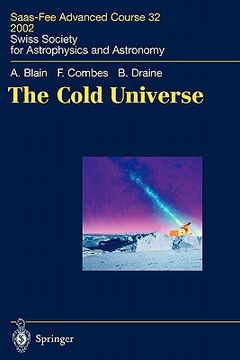Compartir
the cold universe: saas-fee advanced course 32, 2002. swiss society for astrophysics and astronomy (en Inglés)
Francoise Combes
(Autor)
·
Andrew W. Blain
(Autor)
·
Daniel Pfenniger
(Ilustrado por)
·
Springer
· Tapa Blanda
the cold universe: saas-fee advanced course 32, 2002. swiss society for astrophysics and astronomy (en Inglés) - Blain, Andrew W. ; Pfenniger, Daniel ; Combes, Francoise
$ 2,574.71
$ 4,291.18
Ahorras: $ 1,716.47
Elige la lista en la que quieres agregar tu producto o crea una nueva lista
✓ Producto agregado correctamente a la lista de deseos.
Ir a Mis Listas
Origen: Estados Unidos
(Costos de importación incluídos en el precio)
Se enviará desde nuestra bodega entre el
Viernes 26 de Julio y el
Lunes 05 de Agosto.
Lo recibirás en cualquier lugar de México entre 1 y 3 días hábiles luego del envío.
Reseña del libro "the cold universe: saas-fee advanced course 32, 2002. swiss society for astrophysics and astronomy (en Inglés)"
Modern astronomy has stretched its domains of exploration tremendously. Not only objects at very large distances and very old states of the Universe can be examined, but also all kinds of radiations and phenomena are now accessible. Astronomers constantly move from considerations about very - luted to very dense systems. Hot and energetic systems, being the easiest to observe, have attracted a lot of attention. However the cold and low energetic states have been so- what neglected, either because being harder to observe they appear unexc- ing, or because being less well known they tend to be ignored. However the Universe background radiation has now been determined as the most perfect known case of a black-body spectrum, a substantial fraction of matter spends some time close to the temperature of this universal thermal bath, before - ingtransformedintostarsorplanets. Someobjects, suchasrapidlyexpanding gas shells in planetary nebulae, may even succeed in reaching a temperature well below the background radiation temperature through the mere action of adiabatic expansion. In view of the highly dynamical and turbulent state of the interstellar medium, hot and cold temperature ?uctuations must be expected, while the clear observational bias is to observe the hot rather than the cold ?uctuations. Fortunately with the accessibility of far-infrared and sub-millimetric instruments such as SCUBA, WMAP, Planck or ALMA, we can expect in the coming years continuous advances in our understanding of these harder to observe cold stages of matter

